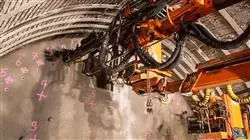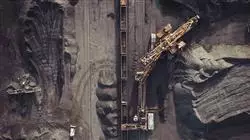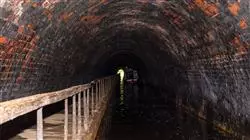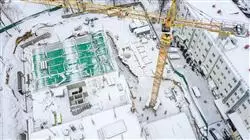University certificate
The world's largest faculty of engineering”
Description
A thorough and intensive study of the differential characteristics of soils and rocks, in relation to soil behavior, bearing capacity or strength"

The program is academically designed to provide in-depth knowledge, starting from advanced concepts already acquired in the world of Civil Engineering and from a practical application point of view, to the most important geotechnical aspects that can be found in different types of civil engineering works.
The content ranges from the specific behavior of soils and rocks, with a constant differentiation of both types of terrain throughout all the topics, to their direct application in foundations and structures.
The program, divided into 10 modules, has a syllabus that mixes some of these modules that have more applied theory (such as those related to soil behavior models, the necessary requirements for a good identification of soils and rocks or the interaction of the soil with seismic disturbances), with others that have an emphasis on practical analysis. The knowledge acquired on the behavior of the soil and its stress-strain states in this first part is applied to the usual structures of Geotechnical Engineering: slopes, walls, screens, tunnels, etc.
Geotechnical engineering and its application in foundations and structures is present in many civil engineering projects and works. This path, which goes from compaction and seismic considerations in linear works to the execution of tunnels and galleries, is the one that is carried out with the case studies addressed in each of the topics. It is a priority to ensure that these case studies are current and relevant. This allows for an original and application-oriented analysis of the theoretical concepts developed throughout the course.
Therefore, the professional master’s degree in Geotechnical and Foundation Engineering integrates the most complete and innovative educational program on the current market in terms of knowledge and the latest available technologies, in addition to encompassing all sectors or parties involved in this field. In addition, the program consists of exercises based on real cases of situations currently managed or previously faced by the teaching team.
All this, through a 100% online program that allows the student to take the course wherever and whenever they want. All they will need is a device with internet access, and they will be able to access a universe of knowledge that will be the main basis for engineers to position themselves in a sector that is increasingly demanded by companies in various industries.
An intensive study of the contents and techniques of Geotechnical Engineering and their application to foundations and structures"
This professional master’s degree in Geotechnical and Foundation Engineering contains the most complete and up-to-date program on the market. Its most notable features are:
- Practical cases presented by experts in Civil Engineering and Geotechnics
- The graphic, schematic, and practical contents with which they are created, provide scientific and practical information on the disciplines that are essential for professional practice
- Practical exercises where the self-assessment process can be carried out to improve learning
- Special emphasis on innovative methodologies
- Theoretical lessons, questions to the expert, debate forums on controversial topics, and individual reflection assignments
- Content that is accessible from any fixed or portable device with an Internet connection
Acquire the working skills required to develop the initial site survey and valuations that are essential for the creation of adequate and safe structures"
The program’s teaching staff includes professionals from the sector who contribute their work experience to this program, as well as renowned specialists from leading societies and prestigious universities.
Its multimedia content, developed with the latest educational technology, will provide the professional with situated and contextual learning, i.e., a simulated environment that will provide immersive education programmed to learn in real situations.
This program is designed around Problem-Based Learning, whereby the professional must try to solve the different professional practice situations that arise during the academic year. For this purpose, the professional will be assisted by an innovative interactive video system created by renowned and experienced experts with extensive experience.
A 100% online refresher program that will allow you to balance your studies with the rest of your daily activities"

Make the most of the opportunity and take the step to get up to date on the latest developments in Geotechnical and Foundation Engineering"
Objectives
Through this program, engineering professionals will acquire the necessary knowledge to analyze the characteristics of soils and rocks, assessing with solvency the suitability of each approach in civil works. With the security and efficiency of a program created to boost professionals in the management and approach of civil works in relation to the land as an imperative technical base, this learning will make you unstoppable on your way to mastering these issues.

Learn to recognize the different types of soils and to adapt the construction works to the behavior that these differences determine, according to the latest technological and scientific developments in the sector."
General Objectives
- Delve deeper into kinds of soil, not only in their typology but also in their behavior. Not only in the evident differentiation of stresses and deformations of soils and rocks, but also under particular but very common conditions, such as the presence of water or seismic disturbances
- Efficiently recognize the needs for soil characterization, being able to design campaigns with the optimal means for each type of structure, optimizing and giving added value to the study of materials
- Identify the behavior of slopes and semi-subterranean structures such as foundations or walls in their different typologies. This complete identification must be based on understanding and being able to anticipate the behavior of the terrain, the structure and its interface
- Know, in detail, the possible faults that each set can produce and, as a consequence, have an in-depth understanding of the repair operations or improvement of materials to mitigate damage
- Carry out a complete review of tunnel and gallery excavation methodologies, analyzing all drilling procedures, design constraints, support and lining
Specific Objectives
Module 1. Soil and Rock Behavior
- Establish the main differences between dynamic and static characterization and behavior of soils and rocks
- Present the most important geotechnical parameters in both cases and their most commonly used constitutive relationships
- Gain detailed knowledge of the different behaviors of terrain and the most commonly used elastic and plastic models for all types of terrain
- Make a presentation of the most common stress cases in practice and soil behavior at different degrees of saturation, swelling and compaction in soils. The fundamental principles of these constraints and their application throughout the development of terrain dynamics and statics are the application parts and objectives for this module
- From the practical point of view, the objectives will be marked by the need to discern all the parameters, stresses, types of stresses and soil and rock concepts. In the same way, we must know which of the constitutive models of the terrain should be used for each of the cases, depending on the characteristics of each of the actions to be approached
Module 2. Terrain Reconnaissance: Characterization and Auscultation
- Define the characteristics to be contained in a specific geotechnical study applied to each particular soil and application requirements
- Establish the concepts included in the most important international standards for sampling and field testing, making a comparison of each one of them
- Acquire in-depth knowledge of the data obtained in field surveys and their interpretation
- Recognize the need to complement field tests with other complementary tests, such as dynamic and static penetration tests
- Acquire the necessary knowledge regarding drilling fluids, both for field testing and for other types of drilling Characteristics, applications, performance, etc.
- Deepen in the practical utility of permeability tests, identifying their fields of application and their convenience
- Make special emphasis on the correct planning of a geotechnical survey campaign, establishing the timing and performance of each phase
- Extend in a practical way the knowledge of laboratory tests Not in terms of definition, which is a known fact, but in terms of being able to foresee the results to be obtained and to identify inappropriate results and malpractice in their execution
- Establish the usefulness of geophysical survey systems
- As far as auscultation is concerned, the main objective of the subject is the recognition of the elements to be auscultated and their actual application on site In addition, new technologies for continuous auscultation are analyzed
Module 3. Behavior of Water in Soil
- Identify of the presence of water in the behavior of soils and acquire correct knowledge of the different storage functions and characteristic curves
- Discuss the terms of effective and total pressures and determine the exact influence of effective and total pressures on the loadings of the land
- Identify the most common errors regarding the use of these terms of effective and total pressures, and show practical applications of these concepts that are of great importance
- Apply knowledge of the behavior of semi-saturated soils in data collection and sample analysis, with regard to laboratory tests: drained and undrained tests
- Determine the uses of soil compaction as a measure to reduce soil saturation. Correctly handle the compaction curve by analyzing the most common errors and their applications
- Analyze the most common saturation processes such as swelling, suction and liquefaction in soils, describing the characteristics of the processes and their consequences in soils
- Apply all these concepts to the modeling of stresses and their variation according to the degree of saturation of the soil
- Know in detail the applications of saturation in surface works and saturation removal processes in superficial linear works
- Correctly define zonal hydrogeology in a project, determining the concepts that should encompass its study and the long-term consequences it may have on structural elements
- Explain in depth the definition of preconsolidation processes as a way to provide soils with improved mechanical properties by reducing soil saturation
- Carry out flow modeling, the permeability concept and its actual application in interim and final construction states
Module 4. Seismicity Continuous Medium Mechanics and Constitutive Models. Application to Soils and Rocks.
- Identify the effects induced in the ground by seismic action, as part of the non-linear behavior of the ground
- Deepen understanding of the particularities of the terrain, discretizing between soils and rocks, and understand the instantaneous behavior under seismic loads
- Analyze the most important regulations in the seismic field, especially in areas of the planet where earthquakes are frequent and of significant magnitude
- Analyze the changes that the seismic action produces in the identifying parameters of the terrain and observe how they evolve depending on the type of seismic action
- Delve into the different practical methodologies for the analysis of ground behavior under seismic conditions, both semi-empirical simulations as well as complex finite element modeling
- Quantify the impact of seismic disturbances on foundations, both in terms of their definition in the design and final sizing
- Apply all of these conditions to both shallow and deep foundations
- Perform a sensitivity analysis of the above-mentioned behaviors in containment structures and in the most common elements of subway excavations
- Apply the study of seismic wave disturbances in other elements that can propagate along the ground, such as the study of noise and vibration transmission in the ground
Module 5. Land Treatment and Improvement
- Acquire comprehensive knowledge of the different types of existing land treatments
- Analyze the range of existing typologies and their correspondence with the improvement of the different properties
- Know precisely the variables that are found in the processes of land improvement by injection: consumption, requirements, advantages and disadvantages
- Present, in an extensive way, gravel column treatments as relatively-little-used elements of land treatment, but with remarkable technical applications
- Gain in-depth knowledge of soil treatments by chemical treatment and freezing, as little-known treatments, but with very good spot applications
- Define the applications of preloading (preconsolidation), which was covered in a previous module, as an element of soil treatment to accelerate the evolution of soil behavior
- Complete the knowledge of one of the most used ground treatments in subway works, such as micropile umbrellas, defining applications different from the usual ones and the characteristics of the process
- Deal in depth with soil decontamination as a land improvement process, defining the typologies that can be used
Module 6. Slope Analysis and Stability
- Determine, for soils and rocks, the stability conditions and behavior of slopes, whether it is stable or unstable, and the stability margin
- Define the loads to which each part of the slope is subjected and the operations that can be carried out on them
- Investigate the potential mechanisms of slope failure and the analysis of practical cases of this type of failure
- Determine the sensitivity or susceptibility of slopes to different mechanisms or triggering factors, including external effects such as the presence of water, the effect of rainfall, earthquakes, etc
- Compare the effectiveness of different remediation or stabilization options and their effect on slope stability
- Learn more about the different options for improving and protecting slopes, from the point of view of structural stability and the conditions to which they may be subjected during their service life
- Design optimal slopes in terms of safety, reliability and economy
- Review the application of slopes in hydraulic works as a major part of the design and use of major slopes
- Detail the calculation methodologies associated with finite elements currently in use for the design of this type of elements
Module 7. Superficial Foundations
- Gain in-depth knowledge of the conditioning factors that influence the design and behavior of shallow foundations
- Analyze the trends in the different international design standards, contemplating their differences in terms of criteria, and the different safety coefficients used
- Recognize the different actions present in shallow foundations, both those that require and those that contribute to the stability of the element
- Establish a sensitivity analysis of the behavior of the foundations in the evolution of this type of loads
- Identify the different types of improvement of foundations already in use, classifying them according to the type of foundation, the soil on which it is located and the age at which it was built
- Break down, in a comparative way, the costs of the use of this type of foundations and their influence on the rest of the structure
- Identify the most common types of surface foundation failures and their most effective corrective measures
Module 8. Deep Foundations
- Acquire detailed knowledge of piles as deep foundation elements, analyzing all their characteristics, construction typologies, auscultation capacity, types of failure, etc
- Review other deep foundations of more specific use, for special structures, pointing out those types of projects in which they are used and in very particular practical cases
- Analyze the major enemies of this type of foundations, such as negative friction or loss of tip resistance, among others
- Have a high degree of knowledge of deep foundation repair methodologies and auscultation, both initial execution and repairs
- Measure, in a correct way and according to the particular characteristics of the work, the appropriate deep foundations
- Complete the study of deep foundations with the upper bracing elements and their grouping, with a clear development of the structural dimensioning of the pile caps
Module 9. Retaining Structures: Walls and Screens
- Define and acquire complete knowledge of the loads that the soil produces on the retaining structures
- Extend this knowledge with the analysis of the interaction of surface loads, lateral loads and seismic loads that may occur in the soil adjacent to this type of structure
- Go through the different types of retaining structures, from the most common continuous screens and piles to other elements of more specific use such as sheet piling or Soldier-piles
- Deal with the deformational behavior of the backside of these elements, both in the short and long term, with special interest in the calculation of surface seating in deep screens
- Learn more about the sizing and behavior of bracing structures, struts and anchors
- Analyze with current finite element calculation methods the most common safety coefficients in this type of structures as well as their correlation by applying statistical reliability concepts
Module 10. Tunnel and Mining Engineering
- Establish the different most common methodologies for tunnel excavation, both those excavated by conventional methods and those excavated by mechanical means
- Be clear about the classification of these methodologies according to the type of terrain, excavation diameters and end use of tunnels and galleries
- Apply the very different soil and rock behaviors defined in other modules of this master's degree to tunnel and gallery excavation
- Recognize the design constraints of the supports and revetments, and understand more deeply their relationship with rock mechanical classifications and soil typologies
- Adapt all these conditions to other types of deep excavation such as shafts, subway connections, interactions with other structures, etc
- Analyze the mining excavation with the particularities it has due to the depth of its actions
- Gain detailed knowledge of the interaction of deep excavations on the surface Performing an approach to seat calculation in different phases
- Establish a concrete relationship between seismic disturbances and the stress-strain behavior of tunnels and galleries, as well as identify how this type of disturbance modifies the supports and linings

A unique specialization that will allow you to acquire superior knowledge to develop in this field"
Professional Master's Degree in Geotechnics and Foundations
.
Due to its extensive field of application, geotechnical engineering stands out as one of the most important areas of engineering today, having its processes, studies and procedure a great adaptation in front of a long list of construction projects of various categories. This situation has generated a significant increase in the labor demand for professionals specialized in this field. Understanding the need for academic updating that accompanies the growing interest in accessing this important occupational field, at TECH Global University we have prepared our Professional Master's Degreein Geotenics and Foundations. In this postgraduate course, special attention will be paid to the new technologies used in the design of geomechanical stations for the geological-geotechnical testing of a construction site. In addition, it will deepen the modernization of the following aspects: the knowledge of the various electrical and seismic methods of geophysical investigation and the identification of the various calculations and studies developed for the understanding of the seismic hazard of a terrain.
Study an online Master's degree in geotechnics and foundations.
The large number of tests, studies and tests developed within the area of geotechnical engineering make this specialty one of the most demanding fields with respect to the level of knowledge of its professionals. In our Master's program you will acquire the necessary skills, knowledge and tools to address the various scenarios that accompany the development of practices in this area. Similarly, in this postgraduate program you will delve into the updating of the following topics: the identification of the implications or possibilities of intervention present in the different methods of soil compaction and the knowledge of the particularities to be considered in the processes of land improvement through the use of injection techniques of high-pressure mixtures.







